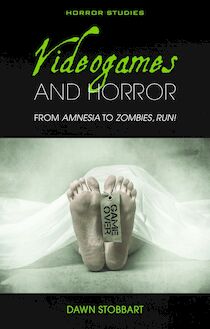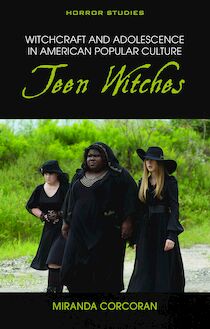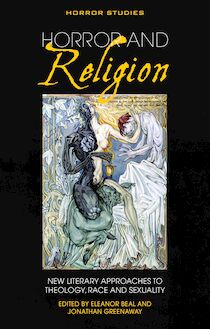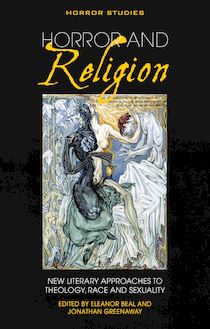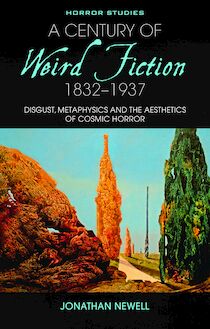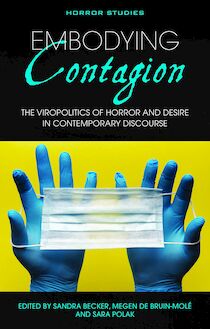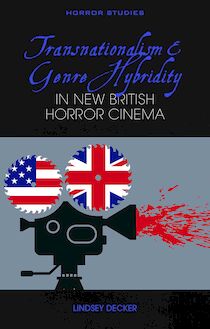-
 Univers
Univers
-
 Ebooks
Ebooks
-
 Livres audio
Livres audio
-
 Presse
Presse
-
 Podcasts
Podcasts
-
 BD
BD
-
 Documents
Documents
-
- Cours
- Révisions
- Ressources pédagogiques
- Sciences de l’éducation
- Manuels scolaires
- Langues
- Travaux de classe
- Annales de BEP
- Etudes supérieures
- Maternelle et primaire
- Fiches de lecture
- Orientation scolaire
- Méthodologie
- Corrigés de devoir
- Annales d’examens et concours
- Annales du bac
- Annales du brevet
- Rapports de stage
La lecture à portée de main
Vous pourrez modifier la taille du texte de cet ouvrage
Découvre YouScribe en t'inscrivant gratuitement
Je m'inscrisDécouvre YouScribe en t'inscrivant gratuitement
Je m'inscrisEn savoir plus
Vous pourrez modifier la taille du texte de cet ouvrage
En savoir plus

Description
While the undisputed heyday of folk horror was Britain in the 1960s and 1970s, the genre has not only a rich cinematic and literary prehistory, but directors and novelists around the world have also been reinventing folk horror for the contemporary moment. This study sets out to rethink the assumptions that have guided critical writing on the genre in the face of such expansions, with chapters exploring a range of subjects from the fiction of E. F. Benson to Scooby-Doo, video games, and community engagement with the Lancashire witches. In looking beyond Britain, the essays collected here extend folk horror’s geographic terrain to map new conceptualisations of the genre now seen emerging from Italy, Ukraine, Thailand, Mexico and the Appalachian region of the US.
Introduction: Dawn Keetley and Ruth Heholt
Part One: Folk Horror’s Folklore
Chapter One: The Frightening Folk: An Introduction to the Folkloresque in Horror
Jeffrey A. Tolbert
Chapter Two: Whose Folk? Community, Folklore, Landscape and the Case of the Lancashire Witches
Catherine Spooner
Chapter Three: Folkloric Origins of the Ukrainian Gothic
Svitlana (Lana) Krys
Chapter Four: ‘Wow, this place is spooky at night!’ Suburban Ennui, Legend Quests and What Folk Horror Shares with Scooby-Doo
Ian Brodie
Part Two: Re-Visioning Canonical Folk Horror
Chapter Five: The Curse of the Cursive: The Horror of the Hand in Folk Horror Film Typography
David Devanny
Chapter Six: The Devil His Due: Folk Horror, Occulture and the Black Magic Story
Timothy Jones
Chapter Seven: Black Boxes: Tradition and Human Sacrifice in American Folk Horror
Bernice M. Murphy
Part Three: Folk Horror in New Places
Chapter Eight: Sunny Landscapes, Dark Visions: E. F. Benson’s Weird Domestic Folk Horror
Ruth Heholt
Chapter Nine: Monsters in the Making: Phi Pop and Thai Folk Horror
Katarzyna Ancuta
Chaper Ten: Curses, Rites and Questionable Offerings: Ludic Folk Horror in Video Games
Tanya Krzywinska
Part Four: Folk Horror’s Politics
Chapter Eleven: Catholicism, Unification and Liminal Landscape in Italian Folk Horror Cinema
Marco Malvestio
Chapter Twelve: ‘Me quitarán de quererte, Llorona, pero de olividarte nunca’: La Llorona, Colonial Trauma and Mexicanness
Valeria Villegas Lindvall
Chapter Thirteen: Sacrifice Zones in Appalachian Folk Horror
Dawn Keetley
Sujets
Informations
| Publié par | University of Wales Press |
| Date de parution | 15 avril 2023 |
| Nombre de lectures | 0 |
| EAN13 | 9781786839817 |
| Langue | English |
| Poids de l'ouvrage | 2 Mo |
Informations légales : prix de location à la page 0,3150€. Cette information est donnée uniquement à titre indicatif conformément à la législation en vigueur.
Extrait
Folk Horror
NEW GLOBAL PATHWAYS
HORROR STUDIES
Series Editor
Xavier Aldana Reyes, Manchester Metropolitan University
Editorial Board
Stacey Abbott, Roehampton University
Linnie Blake, Manchester Metropolitan University
Harry M. Benshoff, University of North Texas
Fred Botting, Kingston University
Steven Bruhm, Western University
Steffen Hantke, Sogang University
Joan Hawkins, Indiana University
Alexandra Heller-Nicholas, Deakin University
Agnieszka Soltysik Monnet, University of Lausanne
Bernice M. Murphy, Trinity College Dublin
Johnny Walker, Northumbria University
Maisha Wester, Indiana University Bloomington
Preface
Horror Studies is the first book series exclusively dedicated to the study of the genre in its various manifestations – from fiction to cinema and television, magazines to comics, and extending to other forms of narrative texts such as video games and music. Horror Studies aims to raise the profile of Horror and to further its academic institutionalisation by providing a publishing home for cutting-edge research. As an exciting new venture within the established Cultural Studies and Literary Criticism programme, Horror Studies will expand the field in innovative and student-friendly ways.
Folk Horror
NEW GLOBAL PATHWAYS
EDITED BY DAWN KEETLEY AND RUTH HEHOLT
The Mowing-Devil; or, Strange News out of Hartford-shire , August 22, 1678.
This book is dedicated to our friends and our patient, kind, and wonderful families
© The Contributors, 2023
All rights reserved. No part of this book may be reproduced in any material form (including photocopying or storing it in any medium by electronic means and whether or not transiently or incidentally to some other use of this publication) without the written permission of the copyright owner except in accordance with the provisions of the Copyright, Designs and Patents Act. Applications for the copyright owner’s written permission to reproduce any part of this publication should be addressed to the University of Wales Press, University Registry, King Edward VII Avenue, Cardiff, CF10 3NS.
www.uwp.co.uk
British Library Cataloguing-in-Publication Data
A catalogue record for this book is available from the British Library.
ISBN 978-1-78683-979-4
eISBN 978-1-78683-981-7
The rights of The Contributors to be identified as authors of this work have been asserted in accordance with sections 77 and 79 of the Copyright, Designs and Patents Act 1988.
The publisher has no responsibility for the persistence or accuracy of URLs for any external or third-party internet websites referred to in this book, and does not guarantee that any content on such websites is, or will remain, accurate or appropriate.
Cover image : ‘Dream by Wombo’ AI cover image, reproduced by permission of Wombo Studios, Inc.
Contents
Acknowledgements
List of illustrations
Contributors
Introduction
Dawn Keetley and Ruth Heholt
Part One: Folk Horror’s Folklore
1. The Frightening Folk
An Introduction to the Folkloresque in Horror
Jeffrey A. Tolbert
2. Whose Folk?
Community, Folklore, Landscape and the Case of the Lancashire Witches
Catherine Spooner
3. Folkloric Origins of the Ukrainian Gothic
Svitlana (Lana) Krys
4. ‘Wow, this place is spooky at night!’
Suburban Ennui, Legend Quests and What Folk Horror Shares with Scooby-Doo
Ian Brodie
Part Two: Re-Visioning Canonical Folk Horror
5. The Curse of the Cursive
The Horror of the Hand in Folk Horror Film Typography
David Devanny
6. The Devil His Due
Folk Horror, Occulture and the Black Magic Story
Timothy Jones
7. Black Boxes
Tradition and Human Sacrifice in American Folk Horror
Bernice M. Murphy
Part Three: Folk Horror in New Places
8. Sunny Landscapes, Dark Visions
E. F. Benson’s Weird Domestic Folk Horror
Ruth Heholt
9. Monsters in the Making
Phi Pop and Thai Folk Horror
Katarzyna Ancuta
10. Curses, Rites and Questionable Offerings
Ludic Folk Horror in Video Games
Tanya Krzywinska
Part Four: Folk Horror’s Politics
11. Catholicism, Unification and Liminal Landscape in
Italian Folk Horror Cinema
Marco Malvestio
12. ‘Me quitarán de quererte, Llorona, pero de olividarte nunca’
La Llorona, Colonial Trauma and Mexicanness
Valeria Villegas Lindvall
13. Sacrifice Zones in Appalachian Folk Horror
Dawn Keetley
Select Bibliography
Notes
Acknowledgements
W E WOULD LIKE to thank Sarah Lewis for her helpful and good-natured support of this project. We would like to thank the wider Folk Horror community for wonderful fictions and texts, imaginative scholarship, and the sense of actual ‘community’ that beams out from online and coalesces in as many conferences as we can manage to get to!
List of Illustrations
Frontispiece The Mowing-Devil; or, Strange News out of Hartford-shire , August 22, 1678.
Figure 2.1 Philippe Handford, ‘1612’, installation on Pendle Hill, Lancashire, United Kingdom, August 2012. Photograph by Graham Demaline.
Figure 5.1 Original illustration of typeface genres.
Figure 5.2 Original reconstruction of film titles in the commercial typeface from which they were derived.
Figure 5.3 The Wicker Man , directed by Neil LaBute (Alcon Entertainment, 2006).
Figure 5.4 Typography before and after in the fictive urban US and rural Sweden in Midsommar , directed by Ari Aster (Square Peg, 2019).
Figure 5.5 Viral marketing campaign, and enhanced detail for Midsommar , directed by Ari Aster (Square Peg, 2019).
Figure 10.1 Cover Image of Clive Barker’s Undying (Westlake/DICE/Dreamworks, 2001). Note the intimate, layered connection between stones and the land with the human skeletal hand, an effective means of representing a common trope in folk horror, the necessity of sacrifice to the earth to ensure its continued fertility.
Figure 10.2 Everybody’s Gone to the Rapture (Chinese Room, 2015). Pastoral idylls. This is a landscape brightly lit, where colours glow and pop; the use of red for the bicycle and some of the flowers here use a complementary schema to help reproduce what would be seen on a clear sunny summer morning.
Figure 10.3 Opening screen image of Year Walk (Simgogo, 2013) showing the Church Grim and setting the visual tone of the game.
Figure 10.4 Year Walk : breaking of the fourth wall, the player’s screen appears to crack.
Figure 10.5 World of Warcraft (Blizzard Entertainment, 2004). Annual ‘Hallow’s End’ celebration: the burning of the ‘Wicker Man’.
Figure 13.1 The yawning pit of the Shookum Hills mine in The Devil Below , directed by Bradley Parker (1inMM Productions, 2021).
Figure 13.2 The abandoned mine and devastated landscape of Shookum Hills in The Devil Below , directed by Bradley Parker (1inMM Productions, 2021).
Contributors
Katarzyna Ancuta is a lecturer at the Faculty of Arts, Chulalongkorn University in Bangkok, Thailand. Her research interests oscillate around the interdisciplinary contexts of contemporary Gothic/Horror, currently with a strong Asian focus. Her recent publications include contributions to Neoliberal Gothic (2017), The Routledge Handbook to the Ghost Story (2017), B-Movie Gothic (2018), Twenty-first-century Gothic (2019), Gothic and the Arts (2019) and The New Urban Gothic (2020). She also co-edited three special journal issues on Thai (2014) and Southeast Asian (2015) horror film, and Tropical Gothic (2019), and two collections on Thai Cinema: The Complete Guide (2018) and South Asian Gothic (2021).
Ian Brodie is a folklorist at Cape Breton University (Nova Scotia, Canada), whose research concerns the intersection of folklore and popular culture with an emphasis on local and marginalised markets. He has served as President of the Folklore Studies Association of Canada and currently the President-Elect of the International Society for Contemporary Legend Research. Along with his co-author Jodi McDavid, Brodie’s work on legendry and belief in children’s television builds on examinations of Märchen and Kunstmärchen in the same medium. His books include A Vulgar Art: A New Approach to Stand-up Comedy (Mississippi, 2014) and Old Trout Funnies: The Comic Origins of the Cape Breton Liberation Army (CBU Press, 2016).
David Devanny is a multimedia artist, writer and researcher. He recently completed a PhD in Publishing Studies at Falmouth University where he is a senior lecturer in English, Writing and Publishing. David’s print work has been published in a wide variety of magazines and in his debut pamphlet, Wasps on the Way (Mews Press, 2012). His multimedia text artworks have been exhibited widely including at Husk Arts Centre, The Hatton Gallery and the Prado Media Lab. He is assistant editor (technology) for Revenant: Critical and Creative Studies of the Supernatural and has presented research at a number of conferences including Haunted Landscapes (Falmouth), Merging Media (Kent), ELO (Bergen, Porto, Cork) and Folk Horror in the Twenty-First Century (Falmouth).
Ruth Heholt is Associate Professor of Dark Economies and Gothic Literature at Falmouth University. She is author of Catherine Crowe: Gender, Genre, and Radical Politics (Routledge, 2020) and co-author of Gothic Kernow: Cornwall as Strange Fiction (Anthem Press, 2022). She is co-editor of several collections including Gothic Britain: Dark Places in the Provinces and Margins of the British Isles (2018) and Haunted Landscapes (2017). She has organised international conferences including Folk Horror in the Twenty-First Century (Falmouth University, 2019) and is editor of the peer-reviewed journal Revenant: Critical and Creative Studies of the Supernatural.
Timothy Jones lectures at the University of Stirling. He is an Associate Editor of Gothic Studies , and his book, The Gothic and the Carnivalesque in American Culture , received the Allan Lloyd Smith prize.
Dawn Keetley is Professor of English, teaching horror/gothic literature, film and television at Lehigh University in Bethlehem, Pennsylvania.
-
 Univers
Univers
-
 Ebooks
Ebooks
-
 Livres audio
Livres audio
-
 Presse
Presse
-
 Podcasts
Podcasts
-
 BD
BD
-
 Documents
Documents
-
Jeunesse
-
Littérature
-
Ressources professionnelles
-
Santé et bien-être
-
Savoirs
-
Education
-
Loisirs et hobbies
-
Art, musique et cinéma
-
Actualité et débat de société
-
Jeunesse
-
Littérature
-
Ressources professionnelles
-
Santé et bien-être
-
Savoirs
-
Education
-
Loisirs et hobbies
-
Art, musique et cinéma
-
Actualité et débat de société
-
Actualités
-
Lifestyle
-
Presse jeunesse
-
Presse professionnelle
-
Pratique
-
Presse sportive
-
Presse internationale
-
Culture & Médias
-
Action et Aventures
-
Science-fiction et Fantasy
-
Société
-
Jeunesse
-
Littérature
-
Ressources professionnelles
-
Santé et bien-être
-
Savoirs
-
Education
-
Loisirs et hobbies
-
Art, musique et cinéma
-
Actualité et débat de société
- Cours
- Révisions
- Ressources pédagogiques
- Sciences de l’éducation
- Manuels scolaires
- Langues
- Travaux de classe
- Annales de BEP
- Etudes supérieures
- Maternelle et primaire
- Fiches de lecture
- Orientation scolaire
- Méthodologie
- Corrigés de devoir
- Annales d’examens et concours
- Annales du bac
- Annales du brevet
- Rapports de stage
